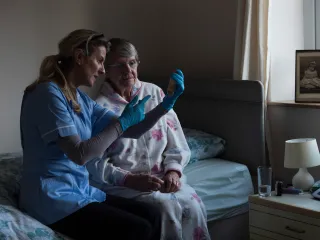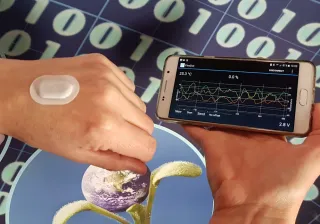Early Parkinson’s disease diagnostics is not currently 100% accurate. There are many symptoms that can be associated with the disease; changes in fine motor skills and tremor being common early indicators. A Scottish company, Manus Neurodynamica, has done 10 years of research to demonstrate that a medical device it has developed can detect these early signs with high accuracy. VTT’s expertise in biomedical signal processing has made this possible.
Key facts
- The NeuroMotor Pen (NMP) can quantify fine motor skill with higher accuracy than the UPDRS-III
- NMPcan make a distinction between the symptoms of Parkinson’s disease and other tremor disorders to support diagnosis
- NMP helps specialists to increase certainty of differential diagnosis (especially PD versus Essential Tremor).
- NMP will increase efficiency and reduce cost compared to DaTSCAN assessment (DaTscan is used to confirm more than 25% of all PD patients at a cost of over £1,000 per scan).
- In triage use, NMP will help GPs increase referral accuracy and save on costs for referrals.
- NMP and treatment validation of PD and other impairments with electronic record keeping.
- Non-invasive; easy to use; can be operated by non-experts.
- Earlier detection and correct treatment of Parkinson’s disease improves the patient’s quality of life.
- High potential for new applications in the future for example in diagnosing dementia.
In the United Kingdom, patients are referred to specialists for a clinical assessment when there is even suspicion that patient’s symptoms are caused by Parkinson’s disease. This has led to extensive queues in health services. Manus Neurodynamica’s unique NeuroMotor Pen (NMP) enables accurate diagnostics, as it can help in differentiating between the subtle differences in symptoms caused by Parkinson’s disease and those caused by other diseases - something that would normally require a highly experienced professional and more expensive diagnostic equipment. The NMP is a device used to make an objective patient assessment of motor symptoms, including tremor, bradykinesia and micrographia, based on standardized handwriting and drawing tasks, offering an earlier, non-invasive diagnosis that employs at a wide scale. In primary care, this can avoid unnecessary referrals of the worried well. Specialists will utilise NMP in case of differential diagnostic uncertainty when often complex and expensive brain imaging techniques are used.

Ten years of fruitful collaboration and promising results
Back in 2009 Manus Neurodynamica was looking for a trusted partner with expertise in biomedical signals processing to further develop the NMP in a European Commission funded research project under the Research for the Benefit of SME scheme. In this research project, VTT researchers conducted biomedical signal analysis of the battery of pen sensor measurements. This analysis can tell for example when the tremors occur, at what frequency and how severe they are, how slow the minute hand and finger movements are in case of bradykinesia, and how much fine motor skills have deteriorated in terms of spatial and temporal accuracy.
This is a completely new way of making a medical assessment with the help of the recorded movements of a pen in a patient’s hand and then trying to connect the detected symptoms to a specific disease
The project encountered challenges when it came to funding, and therefore both Manus Neurodynamica and VTT had to be resilient in order to push the process forward.
The dedication to solving the customer’s problem, as well as long-term commitment, are at the core of VTT’s research, and that has been evident in this project
The pen and the tablet that test subjects write and draw on have been developed side by side with the data analytics and with the app that administer the test along with cybersecurity solutions that comply with medical standards.
The two core components of the NeuroMotor Pen product are the Pen and the proprietary analytics - algorithms for rating fine motor skill and differential diagnostic assessment. Our unique analytics have been largely developed by our long-term collaborators at VTT under the leadership of Prof Mark van Gils, who have made a very significant contribution to the development of our groundbreaking technology. It is thanks to their experience of signal processing in a medical context, that along with clinical input, it has been possible to achieve the very high accuracy of the NeuroMotor Pen.
During the research project, it showed that the NMP measurements offer a reproducible measure of the fine motor movements of the hand, which can be used to measure medication effect and to separate patients with Parkinson’s disease from patients with other tremor syndromes with high accuracy. It confirmed that the accuracy that achieved with the NMP is higher than the Unified Parkinson’s Disease Rating Scale (part III – motor skill) for fine motor skill assessment. Additional benefits include objectivity and electronic record keeping. The accuracy for separating the Parkinson’s disease from essential tremor, which is the most common of tremor syndromes, was 80 % in a cohort that required DatSCAN to confirm the diagnosis.
Improved treatment of neurological diseases on the horizon
The NMP will allow for earlier and more accurate detection and treatment of Parkinson’s disease, which will significantly improve the patient’s quality of life. At the same time, those who have symptoms caused by another disease can also find correct treatment and avoid unnecessary medication. NMP will make the future of patient care brighter while significantly reducing the costs of health care services. Manus Neurodynamica has already achieved early adoption in both research and clinical markets and is seeing a demand in treatment validation and in the NMP sensor technology and analytics in other applications areas, such as early signs of dementia and quantifying the motor side effects of medication for the purpose of treatment optimisation.
VTT already uses their related expertise in other research, for example research where the gait of a subject is analysed to produce information about the risk of falling and signs of dementia.




